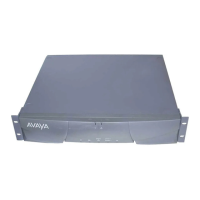PKT-INT (Packet Interface)
Issue 1 May 2002
8-1239555-233-143
In addition to affecting telephone service, a failure of one or both of the PN’s
Packet Interfaces affects service provided by circuit packs that connect to the
packet bus. For example:
■ TN464C, TN2207, TN2464 Universal DS1 circuit pack — ISDN-PRI
service
■ TN556, TN2198, TN2185 ISDN-BRI Line circuit pack — ISDN-BRI service
■ TN2305, TN2306 ATM
■ TN570 Expansion Interface (EI)
■ TN573 Switch Node Interface (SNI)
■ TN799DP Control LAN (C-LAN) packet port circuit pack
■ TN2501 Voice Announcements over the LAN (VAL)
If the active IPSI’s Packet Interface causes a MAJOR alarm in a high- or
critical-reliability system (with duplicated IPSIs), an IPSI interchange occurs if the
standby IPSI’s state of health (SOH) is high enough to permit the interchange. A
MAJOR alarm due to a failure of the standby IPSI’s Packet Interface lowers the
standby’s SOH, preventing a subsequent interchange.
The links that pass through the Packet Interface circuit are identified as either
“application” or “system” links as follows:
1. Application links
a. Endpoints requiring connectivity to the media server via the C-LAN
board’s Socket interface.
These links pass over the packet bus, and through C-LAN ports.
The following system features use application links of this type.
■ Call Detail Recording (CDR)
■ Dial-up administration
■ Property Management System (PMS)
■ Journal printer
■ Wake-up log printer
■ Announcement circuit pack upload/download of recorded
messages
■ IP phones
2. System links
■ Expansion Archangel links (signaling links for call setup of an PN’s
endpoints)
■ Center Stage Control Network (CSCN) links
■ ISDN-PRI D-channel signaling links
■ ISDN-BRI D-channel broadcast and point-to-point signaling links
■ Adjunct Switch Application Interface (ASAI) links
■ Remote Socket Control Link (RSCL) (C-LAN, VAL)
■ BRI (TRK and STA)

